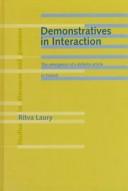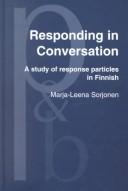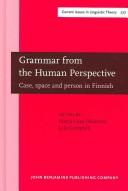| Listing 1 - 10 of 14 | << page >> |
Sort by
|
Multi
ISBN: 9786613234100 1283234106 9027282226 9789027282224 9781283234108 1588114430 9781588114433 9027227888 9789027227881 Year: 2003 Publisher: Amsterdam Philadelphia J. Benjamins
Abstract | Keywords | Export | Availability | Bookmark
 Loading...
Loading...Choose an application
- Reference Manager
- EndNote
- RefWorks (Direct export to RefWorks)
This monograph examines the structure and properties of Finnish manner adverbials. The central idea is that, instead of AdvPs, DPs, APs, PPs, NumPs and InfinitivalPs, manner adverbials have the form of either kPs or pPs, and they are licensed as unique specifiers of a manner-related small vP. Secondly, because "obligatory" and "optional" manner adverbials are merged as specifiers of one and the same small vP, the computational system of language sees no difference between them. This is why "obligatory" and "optional" manner adverbials often behave in exactly the same way with regard to syntactic operations such as movement. Thirdly, the author shows that, although all arguments and VP-internal adverbials are merged as specifiers of a unique small vP, this hierarchical structure need not always be reflected in an unambiguous linear order: in many languages VP-internal manner, place and time adverbials are allowed to permute freely because they have no features which would need checking by the features of a higher functional head, and because their original Spec,vP positions are "invisible" to the Linear Correspondence Axiom. Although the argumentation and analyses are mainly supported by Finnish data, the author also shows how they can be applied to other languages. The book also contains an extensive introduction to Finnish, to help readers unfamiliar with the language to follow the discussion.
Finnish language --- Baltic-Finnic languages --- Adverbials.

ISBN: 1283424290 9786613424297 9027275815 9789027275813 1556193734 9781556193736 9027226172 9789027226174 Year: 1997 Publisher: Amsterdam Benjamins
Abstract | Keywords | Export | Availability | Bookmark
 Loading...
Loading...Choose an application
- Reference Manager
- EndNote
- RefWorks (Direct export to RefWorks)
This book concerns one of the paradigm examples of grammaticalization, the development of a definite article from a demonstrative determiner. Although standard written Finnish has no articles, the demonstrative se is currently emerging as a definite article in spoken Finnish. This book describes and explains the developing use of se based on a database consisting of spoken narratives from three different periods spanning the last one hundred years.
Finnish language --- Baltic-Finnic languages --- Demonstratives. --- Article --- History. --- Pronoun. --- Grammar
Book
ISBN: 9522227544 9522227552 9522226742 9789522227553 9789522227546 Year: 2016 Publisher: Helsinki : Finnish Literature Society / SKS,
Abstract | Keywords | Export | Availability | Bookmark
 Loading...
Loading...Choose an application
- Reference Manager
- EndNote
- RefWorks (Direct export to RefWorks)
"The Protestant Reformation began in Germany in 1517, and the adoption of Lutheranism was the decisive impetus for literary development in Finland. As the Reformation required the use of the vernacular in services and ecclesiastical ceremonies, new manuals and biblical translations were needed urgently. The first Finnish books were produced by Mikael Agricola. He was born an ordinary son of a farmer, but his dedication to his studies opened up the road to leading roles in the Finnish Church. He was able to bring a total of nine works in Finnish to print, which became the foundation of literary Finnish. The first chapter outlines the historical background necessary to understand the life's work of Mikael Agricola. The second chapter describes Agricola's life. Chapter three presents the Finnish works published by Agricola. The fourth chapter is a depiction of Agricola's Finnish. Agricola carried out his life's work as part of a network of influential connections, which is described in chapter five. The sixth chapter examines the importance of Agricola's work, research on Agricola and Agricola's role in contemporary Finnish culture. The book mainly focuses on language and cultural history, but in terms of Church history, it also provides a review on the progression and arrival of the Reformation to Finland. Finnish is a Uralic language but the source languages of Agricola's translations - Latin, German, Swedish and Greek - were all Indo-European languages. Thus, the oldest Finnish texts were strongly influenced by foreign elements and structures. Some of those features were later eliminated whereas others became essential constituents of standard Finnish. To illustrate this development, the Finnish in Agricola's works has systematically been compared with the standard contemporary language."
Finnish language --- Standardization. --- History. --- Agricola, Mikael, --- Baltic-Finnic languages --- Agricola, Makail, --- Agricola, Michael, --- Agricola, Michael Olavi,
Book
ISBN: 1283574373 9786613886828 9027272727 9789027272720 9781283574372 9788776742492 8776742490 Year: 2007 Volume: v. 23 Publisher: Odense University Press of Southern Denmark
Abstract | Keywords | Export | Availability | Bookmark
 Loading...
Loading...Choose an application
- Reference Manager
- EndNote
- RefWorks (Direct export to RefWorks)
Der vorliegende Band, der auf ein interdisziplinäres Symposion Morphologische Probleme in den Sprachen der Ostseeanrainer im September 2005 am Alfried-Krupp-Wissenschaftskolleg Greifswald zurückgeht, enthält Beiträge von Norbert Endres (Greifswald), Frank Heidermanns (Köln), Arend Quak (Amsterdam), Klaus Dietz (Berlin), Lucia Kornexl (Greifswald), Thomas Klein (Bonn), Dieter Möhn & Ingrid Schröder (Hamburg), Steffen Krogh (Århus), Andrea de Leeuw van Weenen (Leiden), Hans Fix (Greifswald), Andreas Schabalin (Greifswald), Dominika Skrzypek (Poznan), Hans Götzsche (Aalborg), Rainer Fecht (Berlin
German language --- Baltic languages --- Finnish language --- Baltic-Finnic languages --- Balto-Slavic languages --- Indo-European languages --- Morphology.
Book
ISBN: 9522227595 9522224081 9522223263 9789522224088 9789522227591 Year: 2016 Publisher: Helsinki : Finnish Literature Society / SKS,
Abstract | Keywords | Export | Availability | Bookmark
 Loading...
Loading...Choose an application
- Reference Manager
- EndNote
- RefWorks (Direct export to RefWorks)
"More than half a million Swedes - one in twenty - is of Finnish descent. This book explores Finnishness, multilingualism and identities of young people with Finnish background in Sweden. What does it mean to grow up in a Finnish family in Sweden? Who are 'real Finns' and what does it take to be(come) one? Is a shared minority language essential for the survival of the minority, or can a minority culture stay viable without it? What is Finnishness and who, in the end, can define ethnicity? How to make sense of, and how to present interviews that are rich with imitations of accents, jokes and laughter? Representations of Finnishness is Sweden is an ethnographic interview study in the domain of applied language studies. This book is aimed at readers interested in sociolinguistics, linguistic ethnography, and the study of identities. Interviewees' voices take a central position in this book and interview excerpts are used not only as illustrations, but also serve as starting points for discussing broader theoretical concepts. The author, Dr. Lotta Weckström, grew up bilingual - Finnish and Swedish - in Finland. She studied linguistics and migration studies in Germany and the Netherlands, and in this longitudinal study encompasses her expertise."
Finns --- Minorities --- Children of immigrants --- Finnish language --- Baltic-Finnic languages --- First generation children --- Immigrants' children --- Second generation children --- Immigrants
Periodical
ISSN: 17368987 22281339
Abstract | Keywords | Export | Availability | Bookmark
 Loading...
Loading...Choose an application
- Reference Manager
- EndNote
- RefWorks (Direct export to RefWorks)
Estonian language --- Finno-Ugric languages --- Estonien (Langue) --- Langues finno-ougriennes --- Periodicals --- Periodicals. --- Périodiques --- Estonian language. --- Finno-Ugric languages. --- linguistics --- philology --- Estonian --- Baltic-Finnic languages --- Finno-Ugric languages --- Fenno-Ugric languages --- Finno-Ugrian languages --- Ugro-Finnic languages --- Uralic languages --- Baltic-Finnic languages --- Linguistics --- Ural-Altaic languages --- estonian --- baltic-finnic languages --- finno-ugric languages

ISBN: 9027250855 1556199481 9781556199486 9789027250858 9789027297457 9027297452 1282161911 9786612161919 Year: 2001 Publisher: Amsterdam Benjamins
Abstract | Keywords | Export | Availability | Bookmark
 Loading...
Loading...Choose an application
- Reference Manager
- EndNote
- RefWorks (Direct export to RefWorks)
This book concerns particles that are used as responses in conversations. It provides much needed methodological tools for analyzing the use of response particles in languages, while its particular focus is Finnish. The book focuses on two Finnish particles, nii(n) and joo, which in some of their central usages have "yeah" and "yes" as their closest English counterparts. The two particles are discussed in a number of sequential and activity contexts, including their use as answers to yes-no questions and directives, as responses to a stance-taking by the prior speaker, and in the midst of an extended telling by the co-participant. It will be shown how there is a fine-grained division of labor between the particles, having to do with the epistemic and affective character of the talk and the continuation vs. closure-relevance of the activity. The book connects theinteractional usages of the particles with what is known about their historical origins, and in this fashion it is also of interest to linguists doing research on processes of grammaticalization and lexicalization.
Finnish language --- Grammar --- Pragmatics --- Interpersonal communication. --- Particles. --- Interpersonal communication --- Communication --- Interpersonal relations --- Baltic-Finnic languages --- Particles --- LANGUAGE ARTS & DISCIPLINES --- Linguistics / Semantics

ISBN: 9027247927 9789027247926 9786612155338 1282155334 902729321X 9789027293213 9781282155336 6612155337 Year: 2006 Volume: 277 Publisher: Amsterdam Benjamins
Abstract | Keywords | Export | Availability | Bookmark
 Loading...
Loading...Choose an application
- Reference Manager
- EndNote
- RefWorks (Direct export to RefWorks)
The papers of this volume investigate how grammar codes the subjective viewpoint of human language users, that is, how grammar reflects human conceptualization. Some of the articles deal with spatial relations and locations. They discuss how basic attributes of human conceptualization are encoded in the grammatical expression of spatial relations. Other articles concern embodiment in language, showing how conceptualization is mediated by one's embodied experience of the world and ourselves. Finally, some of the articles discuss coding of person focusing on the subjectivity of conceptualization and how it is reflected in grammar. The articles show that conceptualization reflects the speaker's construal of the situation, and furthermore, that it is intersubjective because it reflects the speaker's understanding of the relations between the speech act participants. The papers deal with Finnish, utilizing the rich resources of Finnish grammar to contribute to issues in contemporary linguistics and in particular to Cognitive Grammar.
Finnish language --- Grammar --- Space and time in language. --- Finnois (Langue) --- Espace et temps dans le langage --- Grammar. --- Case. --- Person. --- Grammaire --- Cas --- Personne --- Language and languages --- Baltic-Finnic languages
Book
ISBN: 1280394773 9786613572691 940120750X 9789401207508 9789042034709 904203470X Year: 1994 Publisher: Amsterdam Atlanta, GA Rodopi
Abstract | Keywords | Export | Availability | Bookmark
 Loading...
Loading...Choose an application
- Reference Manager
- EndNote
- RefWorks (Direct export to RefWorks)
Baltic-Finnic languages --- Germanic languages --- Teutonic languages --- Indo-European languages --- Balto-Finnic languages --- Finnish languages --- Finnic languages --- Influence on Baltic-Finnic.
Periodical
ISSN: 17369290 22283854
Abstract | Keywords | Export | Availability | Bookmark
 Loading...
Loading...Choose an application
- Reference Manager
- EndNote
- RefWorks (Direct export to RefWorks)
Finnish language --- Estonian language --- Comparative linguistics --- Comparative linguistics. --- Grammar, Comparative --- Estonian --- Finnish --- Finnish. --- Estonian. --- Finnish language --- comparative research --- second language learning --- foreign language learning --- Comparative philology --- Philology, Comparative --- Historical linguistics --- Baltic-Finnic languages --- Ural-Altaic languages --- estonian language --- finnish language
| Listing 1 - 10 of 14 | << page >> |
Sort by
|

 Search
Search Feedback
Feedback About UniCat
About UniCat  Help
Help News
News